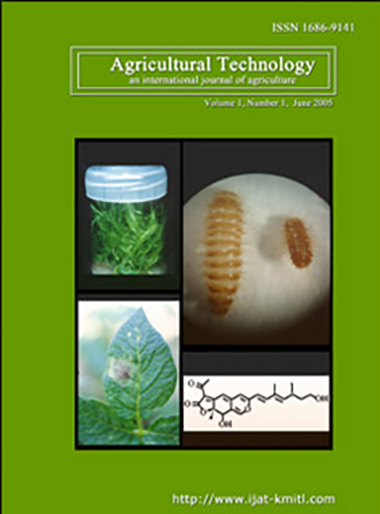Production potential of water-soluble Monascus red pigment by a newly isolated Penicillium sp.
Main Article Content
Abstract
A new isolate from medicinal plant endophytes was identified as Penicillium sp. (HKUCC 8070). A water-soluble red pigment was produced by this strain in potato-dextrose broth, maltextractbroth and a chemically defined medium containing glutamate as a nitrogen source. The red pigment produced was identified as heat-stable, polyketide Monascus red pigment. The highest yield of the red pigment was 1107 mg l-1 obtained from the culture of Penicillium sp. (HKUCC 8070) grown on the malt-extract medium.
Article Details

This work is licensed under a Creative Commons Attribution-NonCommercial-NoDerivatives 4.0 International License.
References
Brown, K.B., Hyde, K.D. and Guest, D.I. (1998) Preliminary studies on endophytic fungal communities of Musa acuminata species complex in Hong Kong and Australia. Fungal Diversity 1: 27-51.
Caldwell, I.Y. and Trinci, A.P.J. (1973) The growth unit of the mould Geotrichum candidum. Archives of Microbiology 88: 1-10.
Chandler, M., Mcintyre, C.R. and Simpson, T.J. (1992) Biosynthesis of LL-D253a, a polyketide chromanone metabolite of Phoma pigmeritivora: Incorporation of 13C, 2H and 18O labelled precursors. Journal of the Chemical Society Perkin Transactions I: 2285-2293.
Chen, M.H. and Johns, M.R. (1993) Effect of pH and nitrogen source on pigment production by Monascus purpureus. Applied Microbiology and Biotechnology 40: 132-138.
Gibbs, P.A., Sevious, R.J. and Schmid, F. (2000) Growth of filamentous fungi in submerged culture: Problems and possible solutions. Critical Review in Biotechnology 20: 17-48.
Hajjai, H., Blanc, P.J., Groussac, E., Goma, g., Uribelarrea, J.L. and Loubiere, P. (1999) Improvement of red pigment/critnin production ratio as a function of environmental conditions by Monascus ruber. Biotechnology and Bioengineering 64: 497-501.
Hajjai, H., Klaébé, A., Loret, M.O., Goma, G., Blanc, P.J. and Francois, J. (1999) Biosynthetic pathway of citrinin in the filamentous fungus Monascus ruber as revealed by 13C nuclear magnetic resonance. Applied and Environmental Microbiology 65: 311-314.
Hajjai, H., Klaébé, A., Goma, G., Blanc, P., Barbier E. and Francois, J. (2000) Medium-chain fatty acids affect citrinin production in the filamentous fungus Monascus ruber. Applied and Environmental Microbiology 66: 1120-1125.
Ho, W.H., Ranghoo, V.M., Hyde, K.D. and Hodgkiss, I.J. (1999) Ultrastructural study in Annulatascus hongkongensis sp nov., a freshwater ascomycete. Mycologia 91: 885-892.
Jûzlová, P., Martinková, L. and Kren, V. (1996) Secondary metabolites of the fungus Monascus: a review. Journal of Industrial Microbiology 16: 163-170.
Kim, C.H., Kim, S.W. and Hong, S.I. (1999) An integrated fermentation-separation process for the production of red pigment by Serratia sp. KH-95. Process Biochemistry 35: 485-490.
Lauro, G.J. (1991) A primer on natural colours. Cereal Foods World 36, 949-953.
Lin, T.F. and Demain, A.L. (1991) Effect of nutrition of Monascus sp. on formation of red pigments. Applied Microbiology and Biotechnology 36: 70-75.
Lin, T.F., Yakushijin, K., Büchi, G.H. and Demain, A.L. (1992) Formation of water-soluble Monascus red pigments by biological and semi-synthetic processes. Journal of Industrial Microbiology 9: 173-179.
Pastrana, L., Blanc, P.J., Santerre, A.L., Loret, M.O. and Goma, G. (1994) Production of red pigments by Monascus ruber in synthetic media with a strictly controlled nitrogen source. Process Biochemistry 30: 333-340.
Romero, A., Carrion, G. and Rico-Gray, V. (2001) Fungal latent pathogens and endophytes from leaves of Parthenium hysterophorus (Asteraceae). Fungal Diversity 7: 88-89.
Shepherd, D. (1977) The relationships between pigment production and sporulation in Monascus. In: Biotechnology and Fungal Differentiation (eds. J. Meyrath, and J.D. Bu'lock), Academic Press, London: 103-118.
Spears, K. (1988) Developments in food coloring: the natural alternatives. Tibtech 6: 283-288. Suryanarayanan, T.S., Senthilarasu, G. and Muruganandam, V. (2000) Endophytic fungi from Cuscuta reflexa and its host plants. Fungal Diversity 4: 117-123.
Trinci, A.P.J. (1969) A kinetic study of the growth of Aspergillus nidulans and other fungi. Journal of General Microbiology 57: 11-24.
Wang, R.H. and Webb, C. (1995) Effect of cell concentration on the rheology of glucoamylase fermentation broth. Biotechnology Techniques 9: 55-58.
Wong, H. and Koehler, P.E. (1983) Production of red water-soluble Monascus pigments, Journal of Food Science 48: 1200-1203.


